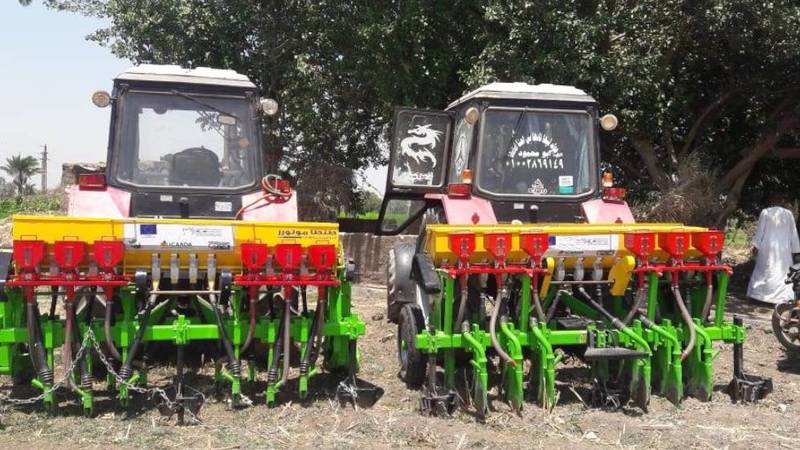Considering socio-ecological diversity for the adoption of new technologies: a case study in Egypt

Water scarcity has been a severe problem for agriculture in Egypt and will continue to pose a challenge in the future. The average water availability per person has already declined below the threshold value of 1000m3 per year and will further drop if agricultural management is not significantly improved.
Negative effects of climate change exacerbate the situation further and reinforce the pressing need for improved agricultural management. If not, recent prognoses suggest that agricultural production could decrease by 8-47% by 2060 which would also lead to employment losses of up to 39%.
Ultimately, Egypt is facing the challenge to produce more food with less water resources - thus the benefits of each water drop applied have to be maximized. Considering this, the adoption of appropriate and suitable irrigation scheduling and innovative irrigation practices and technologies by smallholder farmers is crucial.
Benefits of MRBT for agricultural management
MRBT is a particular field arrangement with widely spaced beds for crops formed by a mechanized plow. Irrigation water is applied to the bottom of furrows among the cropping beds instead of being spread over the whole surface of the cropping area. This way, MRBT is enhancing water productivity and increases the efficiency of water application in irrigated systems. In fact, half the water is needed to irrigate the same amount of crops, using MRBT. Thus, plenty of water can be saved by adopting this innovative technology. Additionally, the adoption of MRBT on experimental farms resulted in an increase of crop production by 10%, net benefits increased by 40% and variable costs reduced by 30%.
Adoption of MBRT by farmers from different socio-economic backgrounds
In the interest of spreading the technology successfully, the factors influencing the decision of farmers to adopt MRBT need to be thoroughly understood. So far, not many studies investigated how different agricultural livelihood contexts influence the adoption rates. Instead, results from analyses of one farm sample have been implied over the study area. Against this background, ICARDA conducted research that analyzed the drivers for adoption of farmer´s households from various socio-ecological backgrounds.
To get a more nuanced and thereby more representative idea of which factors are decisive drivers for farmers from a specific socio-economic background ICATDA employed an agricultural livelihood system (ALS) typology-based approach to its study. A random sample of 360 individual household farms in the governorates of Sharkia and Assiut of Egypt was selected. 180 of them practiced traditional farming methods, the other half had adopted MRBT.
The data of the households was subjected to various consecutive empirical analysis using statistical methods. Firstly, the research identified the factors that differentiates the livelihood types and classified the households into three distinct ALS types: ALS type one consists of poor household-farms main income-based on non-agricultural activities at low cost and less access to local market institutions. Often household members have low-cost, non-farm activities in town as they live closer to urban centers compared to the other ALS types. ALS type two includes medium household-farms with balanced income from crop, livestock and non-farm income. Compared to other ALS types they are sensitive to activities of local market institutions. ALS type three comprises medium household-farms with livestock income from cattle.
Following this, a multivariate adoption analysis was conducted for each ALS type to figure out adoption drivers within the specific livelihood types. Parallel, common determinants (not livelihood type-specific) of farmer´s adoption of MRBT were as well assessed. To learn in more about the various steps of analysis please read the scientific article here.
Discovering hidden causal relationships
This approach of classifying the agrarian population into ALS groups helped discover hidden causal relationships influencing the adoption of MRBT that would not have been identified by considering the sample only as a whole. One example was that the effectiveness of agricultural institutions like WUA and AMA was found to play a significant role in MRBT adoption. This result was found by looking at specific ALS types rather than looking at the whole sample as merged population. Based on this insight the study underlines the need to strengthen the capacity of existing organizations and to establish new ones.
Ultimately, the ALS typology-based approach added value by discovering new causal effects that could not have been found by the traditional approach. To enhance technology adoption by farmers, it is important for policymakers and developers of new technology to understand the farmers’ needs as well as their ability to adopt the technology. Considering this, the study assesses the ALS typology-based approach to be essential to understand the factors that influence adoption. Moreover, the study sees the insights the ALS typology-based approach can put forth as crucial for planning and executing technology-related programs that are urgently needed to meet the challenges of food production in Egypt.
References:
- Adaptation Technologies in Agriculture: Adoption and Impact Assessment of Raised Bed Farming System Technology (RFST) in Egypt
- 30/09/2019. MDPI. A Typology-Based Approach for Assessing Qualities and Determinants of Adoption of Sustainable Water Use Technologies in Coping with Context Diversity: The Case of Mechanized Raised-Bed Technology in Egypt by Quang Bao Le and Boubaker Dhehibi
- 09/09/2019. SciDev Article
